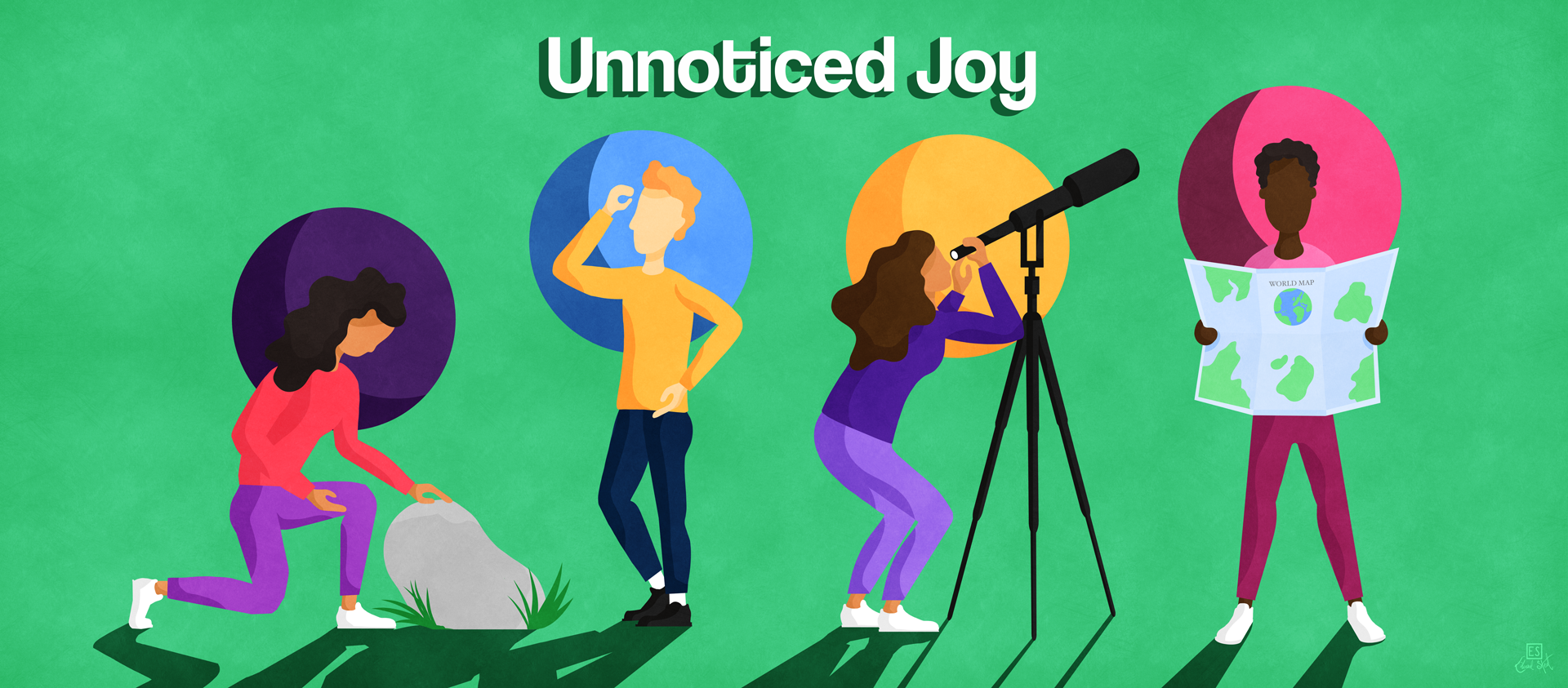Unnoticed Joy (Lent 2/Easter)

Lent 2/Easter, April 2022 (3-30 April). See the Resource Pack PDF for information on the weekly subthemes and the daily prompts and Bible readings which shape our Daily Worship. See the Study Questions PDF to see the material adapted for small Connect groups or personal Bible study.
We are called to look up and see heaven’s open door.
Our Lenten Daily Worship has been divided into two parts. The first part of our study during the month of March engages with our Restless Souls, exploring the idea that we are citizens of heaven with eternity written in our hearts. In these readings we are seeking to minister to the feelings of stress and anxiety that so many of us have had to deal with during the past two years.
 Our scripture passages this month seek to help us discover responses of love and hope that will strengthen our faith and give us cause to believe that our restlessness can be used to turn us into active participants bringing about a more generous and just society; a restlessness in pursuit of the joy Jesus speaks of in John 16: 21-24, about the joy that comes through pain.
Our scripture passages this month seek to help us discover responses of love and hope that will strengthen our faith and give us cause to believe that our restlessness can be used to turn us into active participants bringing about a more generous and just society; a restlessness in pursuit of the joy Jesus speaks of in John 16: 21-24, about the joy that comes through pain.
Augustine — the great Christian thinker, philosopher and Bishop of the 4th century — speaking to God wrote, “You arouse us so that praising you may bring us joy, because you have made us and drawn us to yourself, and our heart is restless until it rests in you.” So in our March reflections while we wrestle with so much uncertainty, we long to encounter the rest that Augustine speaks of which brings us joy. First we may have to travel through the wilderness like the Children of Israel, or discover that we each have our time like shooting stars living to the praise of his glory, or like a mother in childbirth, we must travel through the pain to enter into the joy.
 Part two invites us to consider God’s new thing! The eternal cost borne by the Father, the Son and the Holy Spirt to redeem humanity. In seeking to bring peace to our restless souls God has displayed his amazing love for us. During the month of April, in part two, we trace the journey that God the Son has made in becoming one of us in the person of Jesus of Nazareth. We reflect upon the joy that sustained his ministry, through the presence of God the Holy Spirit and the love of God the Father.
Part two invites us to consider God’s new thing! The eternal cost borne by the Father, the Son and the Holy Spirt to redeem humanity. In seeking to bring peace to our restless souls God has displayed his amazing love for us. During the month of April, in part two, we trace the journey that God the Son has made in becoming one of us in the person of Jesus of Nazareth. We reflect upon the joy that sustained his ministry, through the presence of God the Holy Spirit and the love of God the Father.
During Holy Week as we read and enter the story of our redemption, the road of sorrow, shame and betrayal he chose to travel for us, we find ourselves broken at the foot of the cross. It is there in our brokenness that somehow we get a glimpse of the joy that awaits us in our healing. Evil can never outdo the power of the cross to redeem the restless hearts of a lost and broken humanity or a broken individual.
 Peace leading into joy then becomes the dominant theme from Easter Sunday onwards. In a short sub-theme we begin to use the empty tomb to speak to us of the peace that goes unnoticed before us in our everyday lives: ending up with the thought of the unnoticed Saviour. Mary mistakes the identity of Jesus only to find her joy is lifted to another plane as she is reminded of the true identity of Jesus. His time had come to ascend to the Father. Yet he would not leave them comfortless. Joy would be made complete by the coming of the Holy Spirit.
Peace leading into joy then becomes the dominant theme from Easter Sunday onwards. In a short sub-theme we begin to use the empty tomb to speak to us of the peace that goes unnoticed before us in our everyday lives: ending up with the thought of the unnoticed Saviour. Mary mistakes the identity of Jesus only to find her joy is lifted to another plane as she is reminded of the true identity of Jesus. His time had come to ascend to the Father. Yet he would not leave them comfortless. Joy would be made complete by the coming of the Holy Spirit.
The Lenten study comes to an end by focusing our attention on the call of the Christian to be ready to give a reason for the hope that lies with us. To be aware that we are treading on Holy ground and that the veil between heaven and earth is thinner than we might ever imagine. We are called to look up and see heaven’s open door. To look up in expectancy for the coming of the baptism of the Holy Spirit to transform our restless hearts into hearts stilled by the peace and joy knowing that heaven is our destination.
Let’s take time to notice the joy.
Each week of the four week theme runs Sunday-Saturday and has its own subtheme, which contains daily Bible readings and prompts for thought (see the Resource Pack PDF for more information). See the Study Questions PDF to see the material adapted for personal Bible study or small Connect groups.





What are people saying?
There are no comments on this article yet... be the first?
I want to say something!